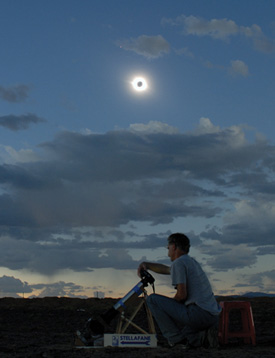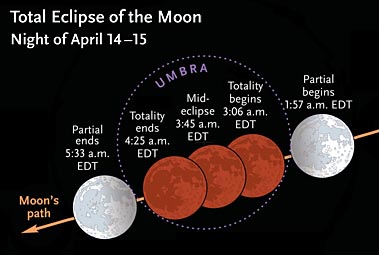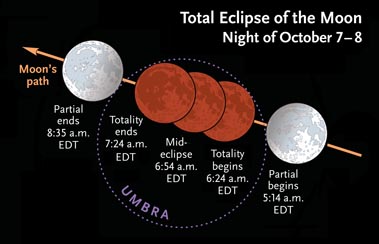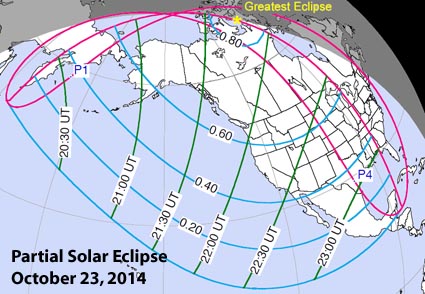Two total lunar eclipses occur this year, the first since late 2011, in April and October. Solar-wise, April's annular 2014 eclipse is only observable from Australia, but North America is well positioned for a partial event in October.
Any list of nature's grandest spectacles would certainly include eclipses of the Sun and Moon. Up to seven of them can take place in one year, though the last time that happened was 1982. The fewest possible is four, as will be the case in 2014. But it's a great quartet — especially because three of these events will be observable from North America.

Few events in nature offer the drama and spectacle of a total solar eclipse, as demonstrated by this one seen over China on August 1, 2008.
S&T: Dennis di Cicco
A solar eclipse happens only at new Moon, when the lunar disk passes directly between us and the Sun. Conversely, a lunar eclipse occurs during full Moon, when our satellite passes through Earth's shadow. These alignments don't occur at every new and full Moon because the lunar orbit is tipped about 5° to Earth's orbital plane — only occasionally do the Sun, Earth, and Moon line up exactly enough for an eclipse to occur. (The technical name for that, by the way, is syzygy.)
2014 Eclipse
Three types of lunar eclipse are possible (total, partial, and penumbral) depending on how deeply the full Moon plunges into or near the umbra, our planet's dark, central shadow. If it goes all the way in, we see a total lunar eclipse that's preceded and followed by partial phases. If the Moon skims part way into the umbra, only the partial phases occur. And if its disk passes just outside the umbra, it still encounters the weak penumbral shadow cast by Earth.
Fortunately, no matter which type occurs, a lunar eclipse is observable anywhere on Earth where the Moon is above the horizon. (But there's still an element of luck involved: December 2011's total lunar eclipse was gorgeous from Los Angeles but completely unobservable from New York.) 2014 eclipse season will provide two total lunar eclipses - the first since 2011.
Because the Moon casts a smaller shadow than Earth does, eclipses of the Sun tightly constrain where you can see them. If the Moon completely hides the Sun, even for a moment, the eclipse is considered total. With its brilliant disk completely covered, the Sun's ghostly white outer atmosphere is momentarily revealed for durations from seconds to several minutes. Last year, for example, hundreds of eclipse-chasers converged in northern Kenya to watch just 11 seconds of totality.
However, this spectacle can be viewed only from a narrow track or path on Earth's surface that's typically just 100 miles (160 km) wide. Outside of that path, about half the world is able to watch a partial eclipse as the Moon obscures a portion of the Sun.
Occasionally the Moon passes directly in front of the Sun but doesn't completely cover it. This circumstance is known as an annular eclipse, so-called because you can see a ring, or annulus, of sunlight surrounding the lunar disk. But an annular's path is likewise narrow, and outside of it observers see only a partial cover-up.
Below are brief descriptions of this year's eclipses of the Sun and Moon. You'll find more details for the two lunar eclipses on this website and in Sky & Telescope magazine as the date of each draws near. Times are in Universal Time (UT) except as noted.

Late-night skywatchers get to witness a total lunar eclipse in the early morning of April 15, 2014. Due to the Moon's off-center path through Earth's umbra, the northern half of its disk should look especially dark during totality. For West Coast observers, early phases of the eclipse occur late on April 14th. Click on the image for a larger version.
Sky & Telescope diagram
April 15: Total Lunar Eclipse
This is the first total lunar eclipse in 2½ years. Skies permitting, April's event is observable in its entirety across North America and western South America; those in Europe and Asia won't see it. It's a late-night, early-morning event, though, with mid-eclipse at 7:46 Universal Time (12:46 a.m. PDT or 3:46 a.m. EDT). Totality lasts 78 minutes. The partial phases run from 5:58 to 9:33 UT (which begin late on the 14th as seen from the West Coast). The Moon passes through the southern portion of Earth's dark umbra, which means the northern half of the eclipsed lunar disk should appear much darker than its southern half. The bright star Spica is positioned just 2° west of the darkened Moon.
Interestingly, April's event is the first of four consecutive total lunar eclipses in 2014–15! Such eclipse tetrads are not common — the last one occurred a decade ago, but the next won't begin until 2032.
April 29: Annular Solar Eclipse
Two weeks later, after the Moon has swung around from full to new, it passes in front of the Sun to create a ring eclipse. However, this event has a rare, peculiar geometry: from nowhere on Earth does the Moon's silhouette appear to be a perfect bull's-eye on the Sun's disk. Instead, an off-centered ring, lasting just 49 seconds, is visible only from a tiny bit of Antarctica — a viewing site so remote that annularity might go unseen by human eyes. Meanwhile, all of Australia and bits of southwestern Indonesia experience a partial solar eclipse that peaks around sunset. For example, Adelaideans can see about half of the Sun's disk covered at 7:07 UT (4:37 p.m. local time).

During the second total lunar eclipse of 2014, the full Moon passes through the northern half of Earth's umbral shadow. During totality, look for the bottom half of the lunar disk to appear much darker than the top half. Click on the image for a larger version.
Sky & Telescope diagram
October 8: Total Lunar Eclipse
The year's second lunar cover-up again favors observers in North America. But it'll be another long night: mid-eclipse is at 10:55 UT (3:55 a.m. PDT or 6:55 a.m. EDT). This timing means the Moon will set during totality for those in eastern Canada and along the East Coast. Skywatchers in Australia and the eastern half of Asia get to view totality shortly after sunset. The Moon's umbral crossing, lasting 59 minutes, is north of the shadow's center, so the southern half of the lunar disk should appear darkest. Partial phases begin at 9:15 UT and end at 12:34 UT. Here are more details about October's lunar eclipse.
By the way, if you want to do more than simply gaze at the eclipsed Moon, several useful observing projects can enhance your experience.
October 23: Partial Solar Eclipse
North Americans are once again favored for a Moon-meets-Sun pairing that occurs two weeks after October 8th's total lunar eclipse. For the best view, you'd go to near Prince of Wales Island in Canada's Nunavut Territory, where the Moon will cover more than 80% of the Sun's diameter.

October 23rd's partial solar eclipse should be seen widely across North America. Green curves give Universal Time of mid-eclipse. Blue curves show maximum fraction of Sun's diameter covered by the Moon.
Source: Fred Espenak / NASA
Barring that adventurous trip, the farther north you live in the U.S. or Canada, the bigger the bite you'll see in the Sun's disk. The partial lunar shadow sweeps northwest to southeast across the continental U.S. For example, mid-eclipse occurs at 3:00 p.m. PDT in Seattle (55% of the Sun's area covered) and 5:53 p.m. CDT in Dallas (30%). Except for the far northeast, a partial eclipse occurs at sunset from the eastern half of the U.S. and Canada. Here's a table of local predictions for major U.S. cities and for cities in Canada and Mexico.
Looking ahead, 2015 will feature two more total lunar eclipses (on April 4th and September 28th), a total solar eclipse visible from the Arctic (March 20th), and a hard-to-see partial solar eclipse (September 13th).
 2
2
Comments
You must be logged in to post a comment.